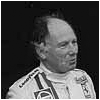26/7/1942
Record updated 26-Jul-07
Son of Andre Pilette, Teddy drove a Brabham BT42 in the 1974 Belgian Grand Prix at Nivelles-Baulers, but was better known for his Formula 5000 and Can-Am exploits. He won the European F5000 title in 1973 and 1975.

Teddy followed his father Andre into the sport but cleared his own path, setting out in Formula Junior in 1962, before switching to sportscars with a spell with the Fiat-Abarth GT team.
In 1965 he used a Fiat-Abarth saloon to win his class in the Belgian championship, and he then became involved in what was to be a long-term association with Count van der Straten's VDS team. Driving an Alfa Romeo T33 and then a Lola T70 in Europe and North America, Pilette showed particularly well in CanAm races, before he and VDS made the switch back to single-seaters in 1971 and the European F5000 championship. The series going into its first evolution, with cars now especially designed to the formula, Teddy's VDS Chevron B28 wrapped up the 1973 title.
In 1974 he joined the legion of private Brabhams at the Belgian GP, the infamous Bretscher-Finotto machines amongst them, for his F1 debut. It was to be a stand-alone entry into GP racing, and it took him another three years to return to F1.
After Bob Evans took 1974 European F5000 honours, Pilette was the second driver to take two European F5000 championships by claiming the 1975 and last title with a Lola T400 before heading to the United States for a season of US F5000.
Then, three years after his Nivelles debut, Pilette was back in F1. At the German Grand Prix at the Hockenheimring, Teddy made an inauspicious debut in the car previously campaigned by Aussie Larry Perkins, Conny Andersson and Guy Edwards. Pilette predictably failed to qualify. At Zandvoort he failed again as he did in Italy.
A glutton for punishment Pilette decided to race the P207 in the inaugural Aurora AFX championship in 1978. Racing against old but good McLarens, Marches and Heskeths the BRM was still hoplessly outclassed. At Oulton Park, Teddy scored his best finish with the car, narrowly beating fellow BRM driver Bob Evans to fourth.
Pilette returned briefly to the racing scene in the mid-nineties at the head of the aptly-named Pilette Speed Tradition, an outfit that once produced the Pilette F3 car that was hopelessly outclassed and was soon consigned to history. In 2000 he embarked on an overseas mission to promote F3 racing in the United States. The PRT team was there during the first United States F3 Championship event, fielding its Dallara-VW F300 and finishing third in the second heat with its driver Paul Jenkins.